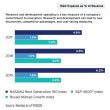by David Mann, Franklin Templeton Investments
Like many people, I have been mesmerised by some of the dramatic recent market moves in stocks like GameStop Corp. and AMC Entertainment Holdings, which you can read about in the financial press. For this discussion, I really don’t want to rehash the impact of retail optimism, Reddit, and various internet message boards on the prices of these stocks—there are certainly plenty of other places to find such commentary.
For this article, I want to think through what would happen if the stock ticker lighting up everyone’s trading monitors was an ETF instead of a single stock.
Quick sidebar: For this discussion, I am only considering ETFs that hold an unlevered basket of stocks. These ETFs could hold stocks of a particular country, sector or theme. Inverse and leveraged stocks would just add another layer of complexity that we can revisit another day.
So, what would happen to our hypothetical ETF if it became the apple of the retail world’s eye? Could it possibly go from $30 to $100 in a single day?
First, let’s start with exhibit 1 and exhibit 2 to illustrate how this seems highly unlikely for ETFs:
- ETFs are open-ended funds
- The price of an ETF is based on the value of its underlying stocks.
For individual stocks, there are only a finite number of shares available for trading, which means market demand often drives the stock price (as we are currently witnessing). ETFs are open-ended funds, which means new ETF shares can be continuously created (by delivering the basket of stocks it holds) to meet that demand.
Next and somewhat related to the first point: since new shares can constantly be created or redeemed, the price of the ETF tends to stay in line with the value of the stocks it holds. If there was massive buying pressure on an ETF, then we would expect the ETF to trade above the price of the basket. That is when ETF arbitrage kicks in—market participants would then a) sell the ETF to investors, b) buy the underlying basket of stocks, c) deliver those stocks to the ETF as part of a creation. (The opposite would also be true if there was significant selling pressure.)
Given those two points, I feel confident that the kind of price spikes we saw in stocks like the ones mentioned above are very unlikely to occur in an ETF. The ETF would need the 50 or 100 or 700 stocks it holds to increase their price by the same percentage. While not impossible, it’s certainly harder than moving up the price of only one stock.
BUT WAIT A MINUTE!!!
Here is a quote from a prior blog on trading and volatility back when the markets were under turmoil in March 2020:
For now, I want to go back to ETF arbitrage. Typically, those disconnects between an ETF’s price and its underlying basket price are very short-lived and very small in scale. However, very rarely—and usually during severe market moves and/or high levels of uncertainty in the values of the underlying securities—the duration of that disconnect can last longer.
Pricing that normally corrects itself in seconds may now take hours. ETF spreads will likely be wider, premium/discounts will be greater, and the trading will actually look more like single stocks or closed-end funds than open-ended ETFs.
Uh oh. Is it possible that the retail demand for an ETF goes bonkers at the exact same time there are high levels of uncertainty in the underlying market? For example, what if the demand for an ETF that only holds Taiwanese stocks started the first day of Chinese New Year when the underlying market is closed for five straight days?
My best guess is that there would be elevated ETF premiums compared with what we normally see during Chinese New Year, but trading would normalise as soon the Taiwan stock market opens back up for trading.
I do have to admit, it is a fun thought exercise…and Chinese New Year is only two weeks away!
Important Legal Information
This material is intended to be of general interest only and should not be construed as individual investment advice or a recommendation or solicitation to buy, sell or hold any security or to adopt any investment strategy. It does not constitute legal or tax advice.
Any companies and case studies shown herein are used solely for illustrative purposes; any investment may or may not be currently held by any portfolio advised by Franklin Templeton. The opinions are intended solely to provide insight into how securities are analysed. The information provided is not a recommendation or individual investment advice for any particular security, strategy, or investment product and is not an indication of the trading intent of any Franklin Templeton managed portfolio. This is not a complete analysis of every material fact regarding any industry, security or investment and should not be viewed as an investment recommendation. This is intended to provide insight into the portfolio selection and research process. Factual statements are taken from sources considered reliable but have not been independently verified for completeness or accuracy. These opinions may not be relied upon as investment advice or as an offer for any particular security. Past performance is not an indicator or a guarantee of future results.
The views expressed are those of the investment manager and the comments, opinions and analyses are rendered as of publication date and may change without notice. The information provided in this material is not intended as a complete analysis of every material fact regarding any country, region or market.
Data from third party sources may have been used in the preparation of this material and Franklin Templeton (“FT”) has not independently verified, validated or audited such data. FT accepts no liability whatsoever for any loss arising from use of this information and reliance upon the comments, opinions and analyses in the material is at the sole discretion of the user.
Products, services and information may not be available in all jurisdictions and are offered outside the U.S. by other FT affiliates and/or their distributors as local laws and regulation permits. Please consult your own financial professional or Franklin Templeton Institutional contact for further information on availability of products and services in your jurisdiction.
Issued in the U.S. by Franklin Templeton Distributors, Inc., One Franklin Parkway, San Mateo, California 94403-1906, (800) DIAL BEN/342-5236, franklintempleton.com—Franklin Templeton Distributors, Inc. is the principal distributor of Franklin Templeton’s U.S. registered products, which are not FDIC insured; may lose value; and are not bank guaranteed and are available only in jurisdictions where an offer or solicitation of such products is permitted under applicable laws and regulation.
What Are the Risks?
All investments involve risks, including possible loss of principal. The value of investments can go down as well as up, and investors may not get back the full amount invested. Generally, those offering potential for higher returns are accompanied by a higher degree of risk. Stock prices fluctuate, sometimes rapidly and dramatically, due to factors affecting individual companies, particular industries or sectors, or general market conditions. For actively managed ETFs, there is no guarantee that the manager’s investment decisions will produce the desired results.
ETFs trade like stocks, fluctuate in market value and may trade above or below the ETF’s net asset value. Brokerage commissions and ETF expenses will reduce returns. ETF shares may be bought or sold throughout the day at their market price on the exchange on which they are listed. However, there can be no guarantee that an active trading market for ETF shares will be developed or maintained or that their listing will continue or remain unchanged. While the shares of ETFs are tradable on secondary markets, they may not readily trade in all market conditions and may trade at significant discounts in periods of market stress.
The companies and case studies shown herein are used solely for illustrative purposes; any investment may or may not be currently held by any portfolio advised by Franklin Templeton.














